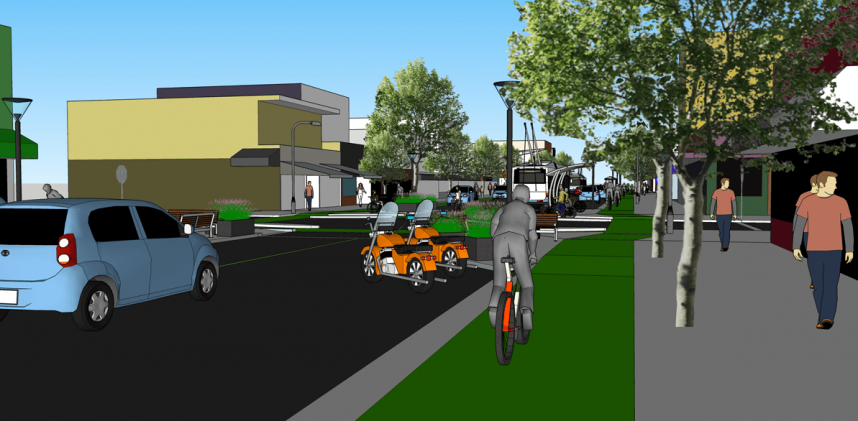Main menu
What Could More Biking Really Mean for Commercial Drive Businesses?
The Commercial Drive Business Society recently sent their member businesses a list of concerns about cycling improvements and negative outcomes from more bikes in the area. The CDBS then asked their members if they supported new bike lanes.
In order to address the inaccuracies and inherent bias of the survey, we present our own list of considerations for the businesses in the Grandview Woodlands community:

Demand
Mode share is high: over 11% of the Grandview Woodlands neighbourhood get around by bike and many people cycle along Commercial Drive to shop, access sevices and to get to their jobs in those shops and services.
Safety
In the City of Vancouver’s Cycling Safety Study, Commercial Drive was shown as one of the most likely places to be in a collision on bike, reflecting its high usage and its inadequate facilities.
The protected bike lane improvements on Hornby Street made the road safer for people walking, cycling and driving reducing crashes by 19%. We expect similar results on the Drive.
The walking experience has improved on Hornby Street as well, with less people cycling on the sidewalk, and more people deciding to walk on the side with the bike lane due to the benefits of motor vehicle traffic buffering.
Tax burden
Cycling infrastructure is actually far less costly to build and maintain than motor vehicle infrastructure. For example, the Hornby protected bike lanes (2km) including full separation, signage, signals, and seasonal plantings, cost the same as one left hand turning bay for cars. Studies find that walking & cycling for transportation brings economic benefit to society, while driving is more highly subsidized by tax dollars.
Decreased customer traffic and "job losses"
Myth. Here are studies that show people cycling end up spending more money in shops than their driving counterparts. We also know that shops thrive on customers, not cars. You can move and park 10x more people cycling than you can in their cars. Research has shown that business owners often underestimate the number of clients coming by bike, foot and transit and overestimate the number coming by car.
The Downtown Vancouver Business Improvement Association has been able to see the true impacts of protected bike lanes, and they came out last year in favour of more cyclist infrastructure. See this and this. Their representative said, "There’s often a disconnect between how businesses think their customers get to their store and what their reality is.”
Parking
Streets for Everyone has done an analysis, backed up by independent analysis, that found that a bike lane can be implemented with no net loss of parking for the section of the Drive that they analyzed for separated bike lanes The experiences of Union Street and downtown lanes has shown that business continues to thrive.
Loading zones
For the downtown protected bike lanes, the City worked with building and business owners to ensure there were adequate loading zones maintained when the bike lanes were constructed. Hornby St. businesses now have lower vacancy rates and higher lease prices, showing that more bikes can bring more business.
Other bike routes
"Lakewood and Woodland run parallel to Commercial Drive, two streets away - why do we need a lane right on the Drive?" Cycling facilities on 'destination streets' - those with multiple businesses - allow people to shop and access jobs and services safely. Cycling along the commercial street gives businesses added exposure and advertising to people on bike, whereas on nearby residential streets you can’t see the businesses or know where to stop. Lakewood and Woodland provide more direct routes for people traveling through the area that do not want to stop.
Topography
Commercial Drive is less steep than Lakewood and Woodland, where current bike routes exist, making it a better choice for more ages and cycling abilities.
Business Support:
The local organization Streets for Everyone has over 20 business supporters on Commercial Drive, so the Commercial Drive BS is not representing all businesses' points of view. Nor is it representing the community's point of view: following an extensive community engagement process, the Grandview-Woodland Citizens' Assembly said 'yes!' to a Commercial Drive bike lane.
What can you do?
1. Email the CDBS - tell them how you get to businesses on the Drive and let them know you support bike lanes: info@thedrive.ca
2. Talk to all the Commercial Drive businesses you visit. Tell them that pedestrians and cyclists shop, and deserve a safe way to get there.
4. Help canvas small businesses - email info@streetsforeveryone.org to let them know how you’d like to help.
For information on the business impact of bikes
Visit the HUB Bike Friendly Business Resource page.
